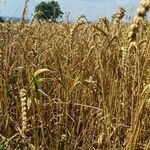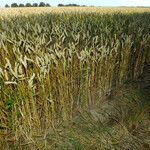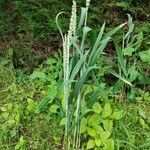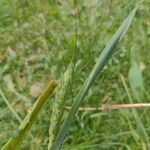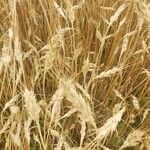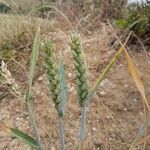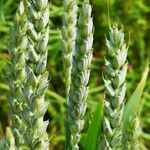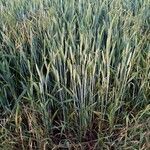Culms hollow, 60–130(–150) cm tall, ca. 5-noded; nodes glabrous. Leaf blade flat, 10–24 × 0.4–1.5 cm, usually glabrous. Spike lax or dense, usually narrowed distally, square or subsquare in cross section, 5–18 cm, with up to 29 spikelets; rachis disarticulating or tough and not disarticulating, margin ciliate; internodes 3–4 mm. Spikelets with 4–9 florets (distal florets sterile). Glumes laxly appressed or adnate to floret, ovate or elliptic, sometimes very hard, distinctly or indistinctly to obscurely keeled, pubescent or glabrous; keel sometimes prolonged at apex into shortish tooth; tooth apex subobtuse, acute, or tapering into short awn. Lemma oblong-lanceolate, pubescent or glabrous, awnless to long awned; awn usually divergent. Palea subequaling lemma. Anthers yellow or purplish. Caryopsis usually free from lemma and palea. Fl. and fr. Apr–Aug.
An annual grass. It easily forms tillers to produce a clump of shoots. Plants grow between 30 and 80 cm tall. The stems are erect and simple. They are usually without hairs. The stems have 5-7 nodes and are hollow between these. The leaf sheath is wrapped around the stem. It is entire at the lower section but split further up. The strap like part where the leaf blade forms is colourless and jagged. The blade is flat, narrow and pointed. It is about 20-37 cm long and 1.2 cm wide. The veins are parallel. The flower stalk or ear is at the end of the stem as a compound spike. It is 5-10 cm long. There are 2 rows of spikelets along each side. Usually 2 grains per spike develop and these are oval with a groove along the centre. There is a tuft of hairs at the end. There are more than 25,000 cultivated varieties.
Plants erect. Culms 63–65 cm high. Leaves with auricles 3 mm long; ligule c. 1.25 mm long, hyaline, truncate; blade 13–20.5 cm long, 7–9 mm wide, flat, acuminate, adaxially minutely scabrous. Spike 9.5–10 cm long, with 16–20 strongly spreading spikelets; sterile spikelets restricted to base of rachis; bisexual spikelets sessile, 10–13 mm long, with usually 3 bisexual florets, with rachilla straight; peduncle glabrous. Glumes: lower glume elliptic, c. 10.5 mm long, c. 3.5 mm wide, muticous or apiculate, chartaceous, 7-nerved. Bisexual florets: lemma ovate, 10–10.5 mm long, acute, apiculate, similar in firmness to glumes, asymmetrically keeled, 10-nerved, with nerves papillose to scabrous and intercostal regions minutely papillose; palea 2-keeled, with nerves apically puberulous.
Annual or winter-annual, 5–12 dm, usually branched below; lvs flat, 2–10(–20) mm wide; spikes mostly 5–10 cm, glumes subequal, 6–10 mm; lemmas 7–12 mm, similar to the glumes, indurate but with scarious margins, the tip broadly lobed and mucronate, or with an awn to 7 cm; anthers 2.5 mm; 2n=42. Eurasian cultigen, often spontaneous in fields and along roadsides with us, probably never truly persistent, but repeatedly re-established.
A heat like plant that keeps growing for several years. It grows 1.5 m tall. It can live for 7-8 years.
